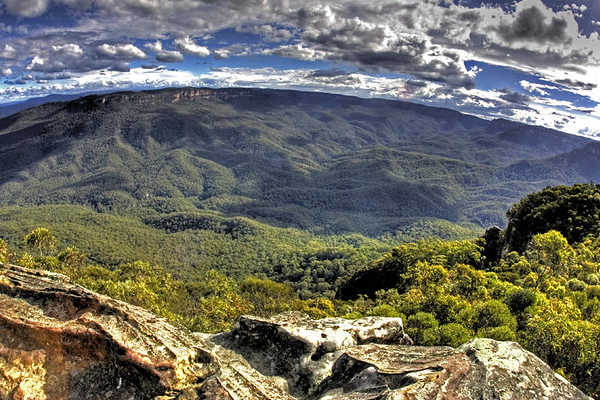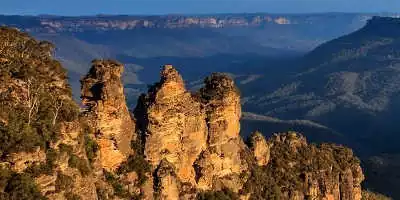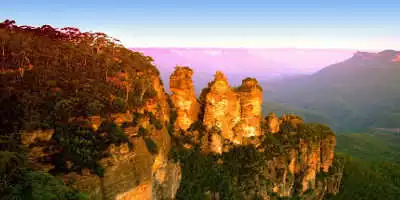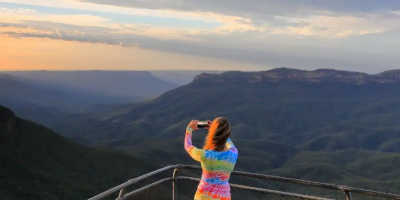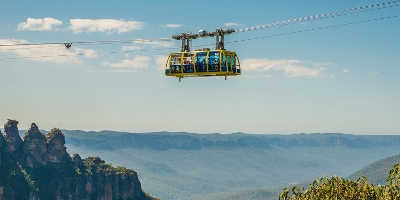Kings Tableland, Blue Mountains
Blue Mountains National Park, New South Wales 2787
The Blue Mountains boast some of Australia’s most spectacular scenery, promising visitors stunning views of velvet mountains, dipping valleys, and lush vegetation.
Throughout the region, there are plenty of things to keep you busy, whether you’re on the hunt for some wildlife spotting opportunities, or want to learn more about the rich history of the area.
There are three valleys you will usually surpass in the Blue Mountains; the Grose, Megalong and Jamison. Throughout these valleys there are number of lookouts onto the wide blue expanse, waterfalls that trickle softly or ferociously rush down the side of cliffs and archaeological wonders from the traditional owners of the land, left behind from a time before Europe settlement. There is much to explore in the 1436 square kilometres that is the Blue Mountains region, whether you’re there for the history, wildlife, or the flora and fauna. Kings Tableland is only one of the iconic natural attractions that you’ll discover on your adventure through the mysterious Blue Mountains.
The Kings Tableland proves to be a popular landmark in the Blue Mountains. It is basically the remains of an eroded sandstone layer that sprawls out for around 1,000m just south of the cascading Wentworth Falls. The plateau was named for King George III by the Governor Lachlan Macquarie, a pioneer in the colonisation of Sydney. Forming the major southern spur of the spine of the mountain range, it marks the gateway to the Southern Escarpment, which is made up of tall sandstone cliffs that edge the Jamison, Megalong, Kanimbla, and Hartley Valleys.
You can find the Kings Tableland to the west of the Blue Labyrinth locality. Surrounding it, you’ll find plenty of beautiful hiking routes and a stunning selection of wild scenery to explore.
The Indigenous History of the Kings Tableland
Like most of Australia’s prominent natural landmarks, Kings Tableland has a history entwined with the Indigenous peoples who live there. Part of the region has been set aside as a camping and meeting place for the Gandangara people. The area set aside for them sits on an impressive sandstone rock platform, which boasts a shelter decorated with ancient rock art. This spot is thought to be the oldest Aboriginal site in the Blue Mountains and contains unique engravings of native bird and animal species, like kangaroos.
If you’re looking to discover some of the immense histories that embrace this part of Australia, this is the place to go. It is thought the Kings Tableland has been used as an Aboriginal gathering place for more than 14,000 years. As a result of this, the area has become an incredibly important element in the story of Australia’s Indigenous heritage.
Today, the Kings Tableland walk – one of the most popular activities in the region – carves through one of the most historically important parts of the Blue Mountains. Here, you’ll find a real-life show of the Australian bushland that has survived for thousands of years.
Along the Kings Tableland walk, you can take a quick diversion out to Rocket Point, where you can soak up stunning views of Wentworth Falls in the distance.
The area is well worth a visit to learn more about Aboriginal history in these parts, and to experience some of Australia’s most picturesque scenery and oldest landmarks.
Walks of Kings Tablelands
The Kings Tablelands Walk is an easy bushwalking trail that takes 45 minutes to complete and around 1.6 kilometres one way. It takes walkers through the sacred Aboriginal meeting place where historic relics have been discovered such as axe-grinding grooves have been found. Once you reach Kings Tableland, the most popular vantage point is the Lincoln Hall lookout. It’s named in honour of a Wentworth Falls residence of the same name, who passed away in 2012. He was an Australian mountain climber who famously was left for dead after getting altitude sickness while climbing Mt Everest. He was rescued the following morning after surviving the bitterly cold and torturous weather conditions on the world’s highest mountain.
Rocket Point Lookout is the place to be for amazing views of the Jamison Valley and Wentworth Falls. It’s considered to be one of the best-kept secrets of the area as it’s only accessible by a side-track that many won’t travel on, instead of sticking to the regular path. From Lincoln’s Rock Lookout it’s about a 30-minute walk on the Little Switzerland Trail in a northern direction.
Nearby Attractions
The nearby McMahon’s lookout which extends out from Kings Tablelands offers amazing views of Lake Burragorang in the Jamison Valley. The lake is a man-made reservoir that is the main water supply for Sydney and the land on which it lies in the traditional home of the Gundungarra tribe. The area is popular with bushwalkers, mountain bike riders and 4×4 driving.
Leading on from McMahon’s Lookout is Wentworth Falls. The town shares its name with a waterfall in the area and is only 8 kilometres or so from the main town of the Blue Mountains; Katoomba. The waterfall is a tiered fall which is accessible by taking the National Pass Walking Trail. It can also be seen from some lookouts in the Jamison Valley.
The only mountain in the Jamison Valley, Mt Solitary, is located South of the main village of Katoomba. From the top of the mountain, breathtaking views of Jamison Valley below, stretching out to Lake Burragorang. It takes a day to walk to the summit but is only recommend for bushwalkers with some experience as it is a challenging walk with a 320-metre ascent.

